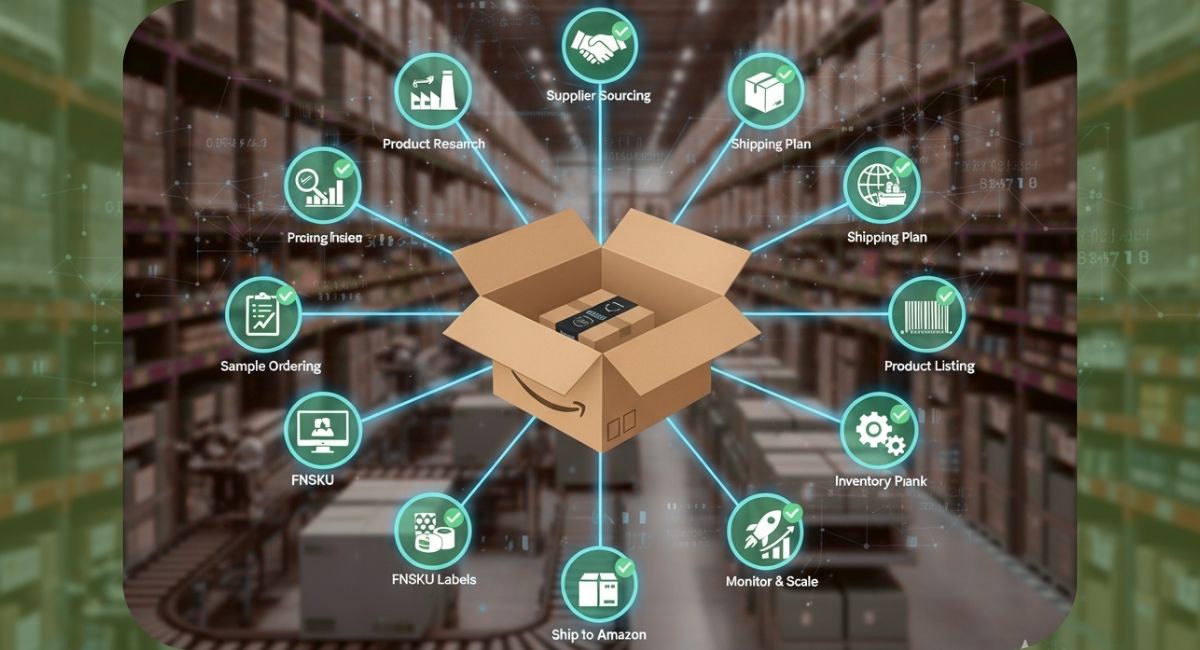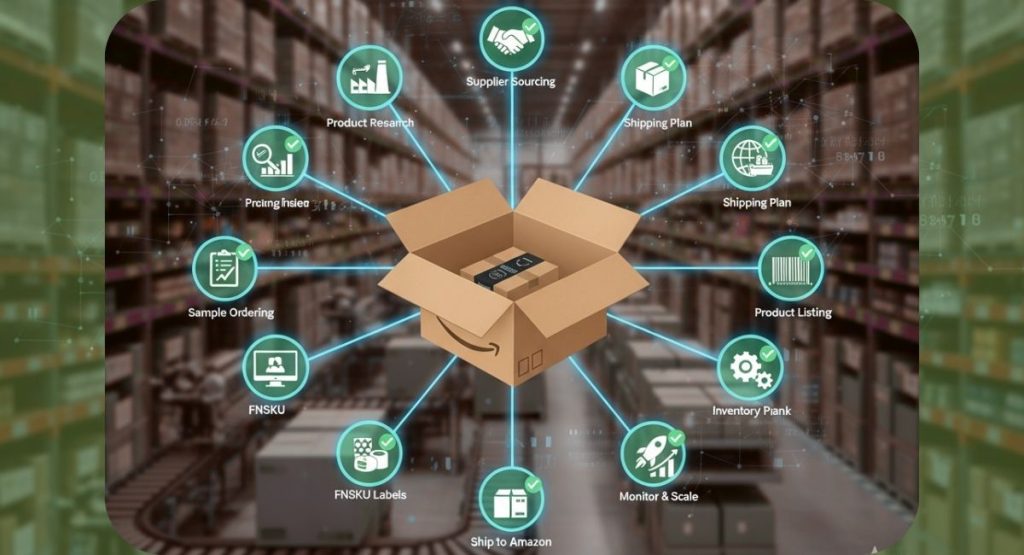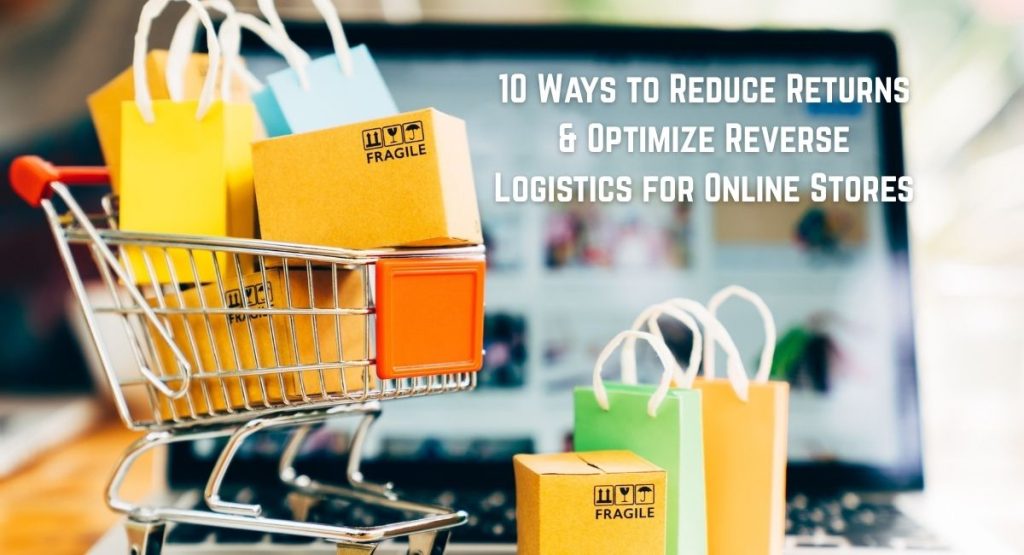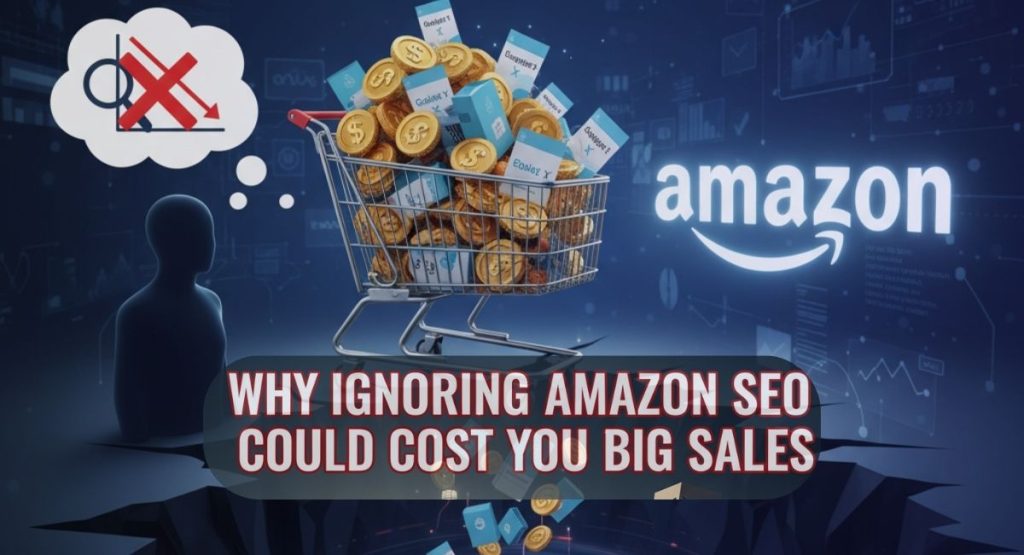Starting an Amazon FBA business can feel overwhelming at first. The idea of selling products to millions of customers worldwide is exciting, but without a structured approach, it is easy to get lost in the details. This guide provides a complete Amazon FBA checklist for new sellers, covering every step from setting up your account to scaling your store. If you want to learn how to start selling on Amazon efficiently and avoid common beginner mistakes, this guide will serve as a practical manual. You can also explore our Amazon eCommerce solutions for professional support while building your store.
Fulfillment by Amazon, or FBA, allows sellers to leverage Amazon’s logistics network. Amazon handles storage, packing, shipping, and even customer service, so you can focus on sourcing, branding, and marketing your products. Many new sellers choose FBA for the access it provides to Prime customers and its trusted service standards. However, successful FBA selling is not just about shipping products; it requires careful planning, strategic research, and consistent optimization.
Step 1: Create and Set Up Your Amazon Seller Account
Your Amazon seller account is the foundation of your business. Without a properly set-up account, it will be difficult to manage products, inventory, and sales efficiently. Here are the essential steps for a smooth setup.
- Choose a professional seller account instead of an individual account. Although the professional account has a monthly fee, it provides access to advanced selling tools, bulk listing options, and eligibility for certain categories.
- Provide accurate business and tax information. Errors in tax IDs or bank details can delay approval or lead to account suspension.
- Complete the identity verification process. Amazon requires documents such as a government-issued ID, business registration, or bank statements. Verification may include a short video call.
- Enable two-factor authentication for added security. This ensures that only you can access your seller account.
Setting up your account correctly prevents many common issues for beginners. For businesses seeking long-term growth, combining an Amazon FBA store with professional web management or development services, like Maxim Blu’s web development services, can help create a seamless workflow and enhance overall efficiency.
Step 2: Conduct Thorough Product Research
Product research is one of the most critical steps in your Amazon journey. Choosing the wrong product can lead to slow sales or inventory losses, while the right product can create a profitable, long-term business. The key is finding a product with steady demand, manageable competition, and the potential for branding.
Consider the following aspects when conducting product research:
- Use tools like Helium 10, Jungle Scout, or Amazon Brand Analytics to evaluate demand, competition, and pricing trends.
- Calculate profit margins carefully. A product with at least a 30 percent margin after all fees is ideal.
- Avoid saturated markets where dozens of similar products compete aggressively.
- Consider seasonal trends. Some products sell only during holidays or specific months, which can affect cash flow.
- Evaluate branding opportunities. Products with room for differentiation through packaging, design, or bundled offers tend to perform better long-term.
Here is a simple table to help evaluate potential products:
| Product Idea | Estimated Cost per Unit | Estimated Selling Price | Expected Margin | Competition Level | Branding Potential |
| Stainless Steel Water Bottle | $5.00 | $15.99 | 45% | Medium | High |
| Silicone Kitchen Utensils | $3.00 | $12.99 | 50% | High | Medium |
| Fitness Resistance Bands | $2.50 | $10.99 | 45% | Medium | Medium |
| LED Desk Lamp | $8.00 | $25.99 | 40% | Low | High |
If you want professional insights into finding trending and low-competition products, Our Amazon product research services provide detailed analysis and recommendations based on real-time market data.
Step 3: Calculate Costs and Plan Your Finances
Understanding the full cost structure of your business is essential before placing your first order. Many new sellers underestimate Amazon fees or shipping costs, leading to unexpected losses.
Here is a detailed example of cost breakdown for a typical FBA product:
| Expense Type | Example Cost per Unit | Description |
| Product Cost | $4.00 | Manufacturing cost from supplier |
| Shipping to Amazon | $0.80 | Freight, customs, and handling fees |
| Amazon FBA Fees | $3.20 | Fulfillment, storage, and transaction fees |
| Packaging & Labels | $0.50 | Custom packaging, labeling, and protective materials |
| Marketing | $1.50 | PPC campaigns, social media promotion |
| Net Profit | $5.50 | Expected profit after all expenses |
A clear financial plan helps you price your products competitively while maintaining healthy margins. Avoid overordering inventory early in your business to reduce risk. Consider starting small and scaling once sales trends are clear.
Step 4: Source Reliable Suppliers
Finding trustworthy suppliers ensures product quality and consistent inventory. Most sellers begin with platforms like Alibaba, GlobalSources, or local manufacturers. Here are some tips to identify reliable partners:
- Request product samples before committing to bulk orders to check quality and packaging.
- Verify supplier credentials and production capacity.
- Negotiate flexible payment terms that allow adjustments for initial orders.
- Confirm lead times and shipping schedules to prevent stockouts.
- Build long-term relationships with suppliers for better pricing and reliability.
Packaging and labeling must meet Amazon FBA requirements. Every product must have a scannable FNSKU barcode, and shipping cartons should follow Amazon’s size and labeling standards.
Step 5: Register Your Brand
Registering a brand adds credibility, prevents listing hijackers, and provides access to advanced features like A+ Content and Sponsored Brands advertising. Here is the step-by-step process:
- Apply for a trademark for your brand.
- Register your brand with Amazon Brand Registry.
- Design a professional logo and packaging.
- Ensure high-quality images and detailed product descriptions.
If you need assistance with visual branding, Our logo design services can help create a professional and memorable brand identity for your products.
Step 6: Prepare Products for FBA Shipment
Preparing your products correctly before shipment ensures smooth processing at Amazon warehouses. Consider the following checklist:
- Label each unit with its unique FNSKU barcode.
- Package products securely to prevent damage.
- Use Amazon’s partnered carrier program to reduce shipping costs.
- Create a shipping plan in Seller Central to organize inventory arrival.
Mistakes like mixing SKUs in a single box or sending improperly labeled products can result in delays or removal requests. Proper preparation saves time and ensures a seamless FBA experience.
Step 7: Create an Effective Product Listing
Your product listing serves as your online storefront. A compelling listing converts visitors into buyers and improves your ranking on Amazon. Here are best practices:
- Write a descriptive title with relevant keywords naturally included.
- Use bullet points to highlight benefits, not just features.
- Include detailed descriptions that tell a story and connect with buyers.
- Add high-quality images, including lifestyle shots, infographics, and product close-ups.
- Conduct keyword research to identify high-traffic, low-competition terms.
For advanced keyword optimization, refer to Maxim Blu’s AI-driven keyword research hacks for strategies that help your listings rank higher and reach more potential customers.
Step 8: Launch Your Product and Drive Sales
After your listing is live, focus on driving traffic and generating reviews. A strategic launch sets the stage for long-term success. Consider these tactics:
- Set up Amazon PPC campaigns to increase visibility and drive initial sales. For professional support, explore our Amazon PPC management services.
- Offer launch discounts or limited-time coupons to encourage early purchases.
- Promote your products through social media and influencer marketing.
- Collect reviews ethically to build social proof and increase conversions.
Content optimization and traffic management are ongoing efforts that influence your product’s performance in the competitive Amazon marketplace.
Step 9: Manage Inventory and Customer Feedback
Inventory management is critical for maintaining sales velocity and avoiding penalties for stockouts. Customer feedback influences product rankings and buyer trust. Here are key practices:
- Monitor inventory levels daily in Seller Central.
- Reorder products ahead of low stock alerts, considering supplier lead times.
- Respond politely and promptly to negative reviews.
- Analyze return reasons to identify quality or shipping issues.
Automating inventory and feedback management can save time. Services like Maxim Blu’s website management services provide tools and support for efficient operations.
Step 10: Analyze Performance and Optimize Listings
Once your products have consistent sales, analyzing performance data is crucial for improvement. Focus on the following metrics:
| Metric | Why It Matters |
| Conversion Rate | Shows how well your listing turns visitors into buyers |
| Click-Through Rate | Measures the effectiveness of titles and ads |
| Advertising Cost of Sales | Indicates PPC campaign profitability |
| Return Rate | Highlights product or packaging issues |
| Inventory Turnover | Helps manage cash flow and prevent overstock |
Based on this data, adjust pricing, listing content, keywords, and advertising strategies. For further guidance on improving product visibility, refer to our tips for product discovery.
Step 11: Scale Your Amazon Business
Scaling involves expanding product lines, entering new marketplaces, and improving operational efficiency. Strategies for scaling include:
- Launch private label products with unique branding. Learn more about Amazon private label services.
- Expand internationally using Amazon’s global selling program.
- Outsource repetitive tasks like customer support or inventory monitoring.
- Optimize listings using AI and SEO strategies for long-term visibility, leveraging insights from our AI SEO services.
Scaling requires a balance of experimentation, data analysis, and consistent execution.
Common Pitfalls to Avoid as a New Seller
Many beginners struggle with these challenges:
- Neglecting to calculate total costs before ordering inventory
- Choosing products based on personal preference rather than market demand
- Underestimating the importance of listing optimization and SEO
- Ignoring customer feedback or failing to respond promptly
- Over-reliance on paid ads without monitoring ROI
Learning from these mistakes helps new sellers avoid costly errors and build sustainable businesses.
Frequently Asked Questions
Q1. How much capital is needed to start an Amazon FBA business
Most new sellers begin with $1,500 to $3,000 covering inventory, fees, and marketing. The exact amount depends on product choice and order volume.
Q2. How long before I start seeing profits
Typically, 3 to 6 months of consistent effort. Profitability depends on product demand, competition, and listing optimization.
Q3. Can I sell on Amazon without a registered business
Yes, but establishing a legal entity is recommended for tax and liability purposes.
Q4. Which product categories are best for beginners
Home and kitchen, pet supplies, fitness accessories, and small electronics often offer manageable competition and steady demand.
Q5. How can I improve Amazon search ranking
Optimize listings with keywords, high-quality images, and verified reviews. Explore Amazon SEO strategies for deeper insights.
Final Thoughts
Starting an Amazon FBA business requires careful planning, research, and ongoing optimization. This extended checklist offers practical guidance for beginners, from account setup to scaling your brand. Every step, from product selection to marketing, influences your long-term success. Partnering with experienced professionals, such as Maxim Blu, can help streamline your operations, optimize listings, and manage campaigns effectively. The journey may be challenging, but with consistent effort, your Amazon store can evolve into a profitable and recognizable brand.
This manual can serve as a roadmap for building a sustainable business and creating a strong foundation for future growth.





